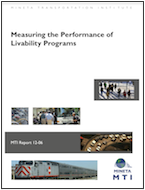- 408-924-7560
- mineta-institute@sjsu.edu
- Donate
Newsletter Winter 2013: Vol. 20, Issue 3
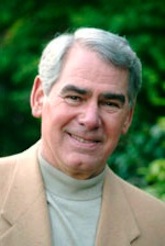 Research proceeds at full-throttle
Research proceeds at full-throttle
Rod Diridon, Executive Director, MNTRC
Rod Diridon
Closing out the second calendar year, the Mineta National Transit Research Consortium (MNTRC) forges ahead at full capacity, serving the the needs of the public transportation community. The past two years have seen a phenomenal number of transit-related studies in progress or production. Credit goes to a fast start by a high-caliber team working on research, education, and outreach.
Education programs thrive in each of the nine universities. San Jose State is one good example, with 87 students participating in an accelerated statewide program for a Master of Science in Transportation Management (MSTM). The June graduating class is nearing 20, which would set a new record. Research programs are also thriving, with 59 projects in progress. Many of those are reaching conclusion and entering the publication phase. Each study reveals important new research data providing valuable insights to the national transportation community. Projects range from from repurposing high-capacity batteries to the reorganization of regional government and transportation programs, all-hazards security and recovery, and high-speed rail connectivity. Each was identified in response to the needs projected by MNTRC clients: the US Department of Transportation, especially the Federal Transit Administration, state departments of transportation, and in many cases, private industry.
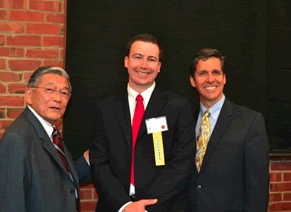
Ret. Transportation Secretary Norman Mineta and California High-Speed Rail Authority's Jeff Morales with MSTM graduate Martin Barna (center).
The proof of the national transportation community’s use of MNTRC research output is that MNTRC’s technology transfer function has organized or co-sponsored 21 summits, forums, and other outreach events this year. This builds upon the 19 professional summits MNTRC organized in 2012. Web site visits totaled 4.5 million this past year, while 2.9 million documents were downloaded from the site. MNTRC researchers have had 15 articles published in professional journals this past year and will present 13 projects at the coming Transportation Research Board (TRB) conference in Washington DC. Indeed, MNTRC is making a difference in improving our national transportation system's development, and operations. And it will continue to do so. Compliments are due to the MNTRC member universities.
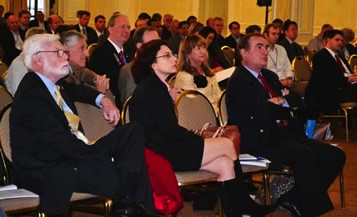
In January 2013, MNTRC organized a high-speed rail summit in Washington DC attended by international transportation leaders.
Board Profile: Beverley Swaim-Staley
Donna Maurillo, MNTRC Director of Communications
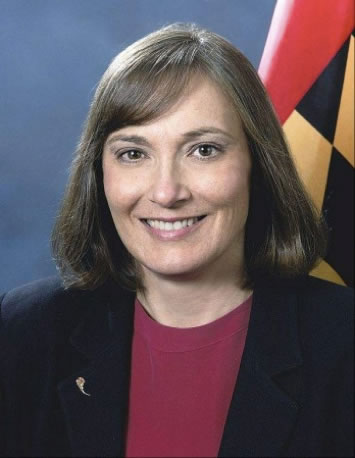
Beverley Swaim-Staley, President and CEO, Union Station Redevelopment Corporation
MNTRC's newest Trustee, Beverley Swaim-Staley, has been breaking ground in the transportation industry. Currently, she is president and CEO of the Union Station Redevelopment Corporation in Washington DC, where she is leading the development and implementation of a comprehensive master plan for the rail station.
She was the first woman appointed as Maryland’s secretary of transportation, with 10,000 employees and a $3.6 billion annual budget. In total, she served for 25 years in state government, including her time as Maryland’s deputy transportation secretary. One of her achievements was to direct all operations at Baltimore-Washington International (BWI) Airport following the September 11 terrorist attacks and the subsequent airport security reforms. Ms. Swaim-Staley led Maryland’s DOT in its first public-private partnership for the Maryland I-95 Travel Plazas and the first airport redevelopment financed by Passenger Facility Charges (PFC) for BWI Airport. She has been praised for her strength in finance and transportation, which helped her guide Maryland’s transportation efforts during the nation’s recent economic recession. The state’s governor, Martin O’Malley, said, “Despite the economic challenges, we made significant progress including the development of an award winning public-private partnership at the Port of Baltimore and the opening of the Intercounty Connector.”
A long and impressive list of accomplishments will add considerably to her value as an MNTRC Trustee. She served as Maryland’s senior representative on the inter-jurisdictional effort to strengthen safety and improve the governance of the Washington Metropolitan Area Transit Authority; oversaw the application of state-of-the-art technology to modernize customer service at the Maryland Motor Vehicle Administration; improved reliability and on-time performance of the MARC commuter rail system; and, shepherded efforts required to maintain the fiscal health of the Maryland DOT and the Maryland Transportation Authority that operates and maintains the State’s eight toll facilities.
As secretary of transportation, Ms. Swaim-Staley spearheaded initiatives to ensure equity, diversity, and minority business development. The Conference of Minority Transportation Officials (COMTO) named her as one of the nation’s most influential women in transportation.
MNTRC is very happy to welcome her aboard because of her leadership and her ability to provide excellent counsel.
Li-Ion battery disposal: turning a negative into a positive
Charles Standridge, PhD, Professor and Assistant Dean
GVSU NEWS – Recently, the federal government approved vehicle performance standards that include a requirement for 54.5 miles per gallon (MPG) by 2025 and a greenhouse gas standard of 163 grams of carbon dioxide equivalent per mile in the same year. One way to meet these standards is to increase vehicle electrification by a variety of means. These include improving existing electric vehicles and plug-in hybrid electric vehicles, as well as creating new means such as the increased presence of start/stop technology.
Lithium ion batteries are an efficient energy storage mechanism, and their use will continue to expand as vehicles are electrified. A fundamental question remains. What is to be done with these batteries once they reach the end of their useful life? There are three possibilities:
- Remanufacturing for reuse in vehicles. Replacing damaged cells within the batteries is an effective remanufacturing strategy.
- Repurposing by reengineering a battery for a non-vehicle application. This usually means developing a different control system for the battery and repairing any damage, as in remanufacturing.
- Recycling those batteries. That means disassembling each cell in the battery and safely extracting the precious metals, chemicals, and other bi-products. These are sold on the commodities market or re-introduced into a battery manufacturing process.
Assessments show promise.
The industry has made progress developing each of these after-vehicle application areas. In addition, it has been able to assess how many of these batteries would be available over time, as well as the economic feasibility of each alternative listed above.
A forecasting model for the number of end-of-vehicle-application lithium ion batteries was used to ensure sufficient supply to support remanufacturing, repurposing, and recycling. The model considered multiple, wide ranging vehicle demand forecasts, a probability distribution of vehicle application life, and a percent useable factor at the end of vehicle life.
Results showed that by 2035, the number of these batteries would range from 1.376 million to 6.759 million, with a middle forecast of 3.773 million. These numbers predict sufficient batteries to justify remanufacturing, repurposing, and recycling. More importantly, the number of these batteries is approximately between 55% and 60% of the number of batteries needed for new production, further supporting the opportunity for remanufacturing. In 2050, this range is predicted to be approximately 70% to 85%, showing a growing opportunity for remanufacturing. These results also indicate that the industry should develop repurposing and recycling processes as well.
Old batteries become new.
A cost benefit analysis was done independently for each of the three types of processing. Costs were included for operations, transportation, material handling, infrastructure development, and facility development. Benefits were many. They included avoiding costs for battery storage and production of new batteries, as well as sales of repurposed batteries and sales of recovered materials in recycled batteries.
Remanufacturing was shown to be cost effective primarily because it avoided costs of producing new batteries when a remanufactured battery could be used instead. Repurposing is a less well-defined application area. However, repurposing was shown to be economical when the development costs of repurposing applications were less than $87 per kWh. Recycling in isolation is not economical, as lithium ion batteries are composed of relatively inexpensive materials. However, recycling can support closed-loop supply chains reusing battery materials for new battery production. It’s also environmentally responsible and sustainable.
Study examines three ways to reduce greenhouse gas
Robert B. Noland, PhD, Director, Voorhees Transportation Center
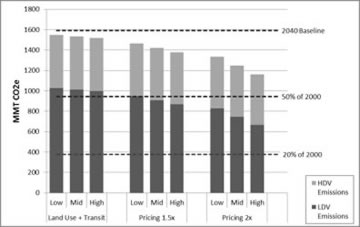
Figure 1: Scenario GHG Emissions
RUTGERS NEWS – Greenhouse gas (GHG) emissions must be reduced 50-80% by 2050 to limit global temperature increase to 2⁰C. It is challenging to achieve reductions of this magnitude in the transportation sector, requiring a multitude of policies and technology options. We are providing here three transportation demand management (TDM) scenarios: changes in the perceived price of travel, land use intensification, and increases in transit. This study uses elasticity estimates derived using an activity-based travel demand model for the state of California. It broadly represents the US; and it is the first analysis of this type to estimate policy impacts using an activity-based model. Argonne National Laboratory’s VISION model is used to quantify the GHG impacts from policy scenarios, providing a life-cycle GHG forecast for the road transportation sector out to 2040 under the most current forecasts for changes in vehicle fleets and fuels.
| Scenario | Arc Elasticity | |||
|---|---|---|---|---|
| LDV | MDV | HDV | ||
| Land Use | Transit-Oriented Development leads to 10% increase in population and job density | -0.31 | -0.46 | -0.01 |
| Transit | Increased investment and new starts doubles transit service | -0.02 | 0.00 | 0.00 |
| Pricing | VMT pricing leads to 50 to 100% increase in per mile driving costs | -0.30 | -0.03 | -0.05 |
Policy Scenario Descriptions
Our team’s scenario analysis suggests that, relative to 2000 levels, only the vehicle miles traveled (VMT) pricing scenarios provide significant reductions in emissions from the 2040 baseline. Increasing the marginal cost of driving by 50% decreases emissions 8-13% relative to the 2040 baseline, or 23-27% relative to 2000 levels.
Some vehicles respond better to pricing policies.
Doubling the marginal cost results in emissions levels lower than the 2040 baseline by 16-27%, a 29-38% reduction from 2000 levels. The land use and transit scenario provides a maximum reduction of about 4.7% from the baseline and a 20% reduction from 2000 levels. The policy for the transit scenario was quite aggressive, doubling the amount of service provided. While the elasticity for increased transit service (-0.02) is within the range of other studies, a doubling of transit service provides little headway towards even the 50% reduction target.
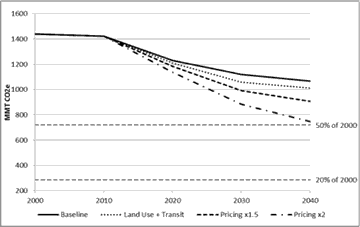
Figure 2: LDV Emission for Individual Scenario
It’s no surprise that the light-duty vehicle (LDV) fleet is much more responsive to our TDM policies than are freight and long distance commercial trucks, which have limited options for increasing load-factors or shifting modes. Under medium-response to the pricing policy, the LDV fleet is able to reduce emissions by very nearly 50% during the period 2040 when pricing is doubled (Figure 2). These results suggest that deeper reductions in emissions may be possible through pricing than have been found in other studies that estimated much lower distance-based pricing charges.
GHG reductions will be difficult to meet.
Technological progress could be made on a variety of fronts, including increased use of electric drive and fuel cell vehicles, further increases in fuel economy, increased use of natural gas in vehicles, and increasing the amount of renewable bio-mass based diesel and ethanol blended into fuels.
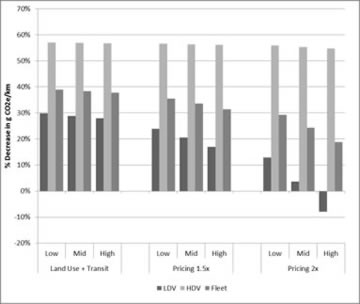
Figure 3: Additional per-mile reductions needed to meet GHG targets.
Rather than looking at the possibilities for each such option, one way to look at how much technological progress is necessary is to examine the per-mile emissions reductions necessary to meet climate policy targets.
Figure 3 illustrates the additional percent per-mile efficiency necessary to meet a 50% target, relative to 2000 for light-, medium-, and heavy-duty vehicles, and all fleet vehicles for each policy option analyzed. These results are sector-specific but show the difficulty with meeting targets for GHG reductions from surface transportation.
Life-cycle reductions of 50% from the 2000 baseline will require aggressive technology policies supplemented with pricing policies. The latter will likely also require supportive land use and transit measures to mitigate the impact of increased travel costs.
San Jose State University News
Research
MTI research attracts attention
Karen Philbrick, PhD, Director of Research
MTI livability research added to L.A. County Metro Transit Authority library.
Mineta Transportation Institute’s (MTI) Research Department generates a great number of valuable peer-reviewed research reports. Of course, MTI has always been proud of that quality. However, it’s even more pride-worthy when others validate the Institute’s perception. For example, a recent report has received national attention, a research request has come from the Netherlands, and the San Diego Metropolitan Transit System is using a training program that MTI developed.
Measuring the Performance of Livability Programs, a recent MTI research report, has received attention from transportation organizations across the nation. The Los Angeles County Metropolitan Transportation Authority has also added this report to the Agency’s Library.
The report analyzes the performance measurement processes adopted by five large “livability” programs throughout the United States. It compares and contrasts these programs by examining existing research in performance measurement methods. Best practices of the examined performance measurement methods for each program are explored and analyzed with respect to their key characteristics.
The report entails an appropriately comprehensive literature review of the current research on performance measurement methods from the perspective of various stakeholders, including the public and government agencies. In addition, the results of this literature review are used to examine the actual performance measures of the target programs from the perspective of different stakeholders.
The report’s goal was to determine what did and did not work in these programs and their measurement methods, while also making recommendations based on the results of the analysis for potential future programs.
Research request from the Netherlands
MTI received a request from the Transport Resource Knowledge Centre (KpVV) in the Netherlands for cooperation in helping them to develop a study on greenhouse gas emissions that replicates the methodology used in MTI’s publication, Greenhouse Gas Emission Impacts of Carsharing in North America. MTI was pleased to share background materials, including questionnaires.
MTI’s safety and security research in action
Finally, the San Diego Metropolitan Transit System is using the Bus Operator Awareness Research and Development Training Program developed by MTI. Through the intensive efforts of four universities and two federal agencies, the MTI-led team conducted extensive research nationally and abroad.
The goal was to identify appropriate countermeasures and related skill sets for bus operators so they could identify suspicious and dangerous activity and react appropriately with a focus on life safety concerns. The research resulted in a 15-minute summary that is an auto-run PowerPoint presentation with a narration and music overlay. This presentation and materials can be displayed in operator break rooms, at safety briefings, during annual refresher training sessions, or in other similar settings.
Education
MSTM students and alumni achieve greatness
Peter Haas, PhD, Director, MTI Education Programs
Since its inception two decades ago, the Master of Science in Transportation Management (MSTM) program at MTI has transformed many graduate students into outstanding transportation professionals. These students are immersed in a ten-semester program that allows them to hold regular employment during the day while attending classes one night per week. Classes are held by way of live streaming to sites throughout California, so students need not travel to the San Jose campus. As a result, MSTM graduates are on track to move into positions of greater responsibility.
Many of them work with leading agencies and businesses, including the California Department of Transportation (Caltrans), Parsons, Los Angeles Metro, Orange County Transportation Authority, and more. Here are a few of their more recent achievements.
- Martin Barna (MSTM 2013) won the 2013 Neville Parker Award for Best Non-thesis Paper in Transportation Policy and Planning. Martin’s paper was titled, “Evaluation of Service Design Characteristics for Concurrent BRT and Local Bus Service in Santa Clara County and Other Urban Corridors.” He will receive the award on January 11, 2014 at the Annual Awards Banquet for the Council of University Transportation Centers (CUTC) in Washington, DC. He also will be awarded a $1500 honorarium. This will mark the third time in five years that the winner of this nationally competitive award has come from MTI.
- Trent Bachman (MSTM 2012) recently assumed the position of Superintendent of Passenger Services, Northeast Corridor (NEC) Business-line for Amtrak. Previously, Trent was Amtrak’s Assistant Superintendent of NEC Service Operations.
- Matthew Sandstrom (MSTM 2010) was named chair of the U.S. Department of Energy Clean Cities Coordinator Council. In his role as Business Development Manager for the Clean Energy Coalition, he also helped launch a bike-share program in Ann Arbor, Michigan. In October, Matt was invited to speak on a panel at the Shared Use Mobility Summit in San Francisco, where he discussed the different ways bike-sharing programs are identifying funding for capital investment in equipment, operations, and expansion.
- MSTM Faculty Matt Raymond has published a book titled Best Practices for Transportation Agency Use of Social Media (CRC Press, October 2, 2013). Robin O’Hara (MSTM 2012) co-authored one of the chapters, “Using Social Media to Connect with Customers and Community.”
- Naomi Armenta (MSTM 2014) has been named MTI's Student of the Year by the Council of University Transportation Centers (CUTC). She will receive a $1000 cash award at the CUTC annual banquet on Saturday, January 11, in Washington DC. She is earning her Master of Science in Transportation Management from MTI and is employed by Nelson/Nygaard Consulting. Naomi also is paratransit coordinator for the Alameda County Transportation Commission.
Information & Technology Transfer
HSR connectivity discussed at APTA annual meeting
Donna Maurillo, MSTM, Director, Communications & Technology Transfer
If the United States is to create successful high-speed and intercity rail systems, then transit must play a key role. Otherwise, passengers in outlying areas or non-station cities will have little or no convenient access. That was the consensus on Tuesday, October 1, as MTI presented “Transit Feeder and Distribution Systems for High-Speed and Intercity Rail: Opportunities to create a Network” at the annual meeting of the American Public Transportation Association (APTA) in Chicago.
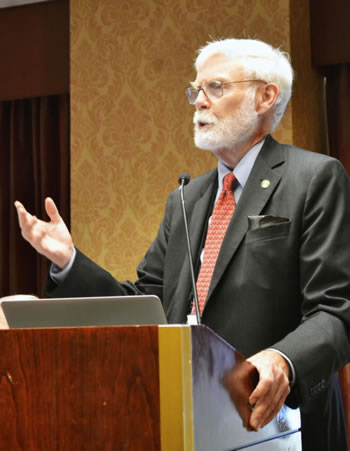
Mortimer Downey, US Deputy Secretary of Transportation (ret.), explains the funding options for connectivity.
The meeting opened with welcoming remarks from Rod Diridon, executive director of MTI/MNTRC, and from David Kutrosky, chair of the APTA High-Speed and Intercity Rail Committee. The keynote address from Mortimer Downey, retired Deputy Secretary of Transportation, was followed by panel presentations from:
- Jeff Morales, CEO, California High-Speed Rail Authority
- Drew Galloway, Chief, Amtrak’s Northeast Corridor Planning and Performance
- Robert Eckels, President, Texas Central High-Speed Railway
- Stanley Feinsod, Director, MTI’s National High-Speed Rail Connectivity Center
Mr. Kutrosky pointed out that connectivity is critical to APTA, especially as California moves ahead on its plans for high-speed rail. “The rail bond in California included $900 million for connectivity,” he said, adding that when the state’s Capitol Corridor rail line added more service in 2006, fare box recovery jumped ten percentage points in only three months.
Modes should coalesce to meet national objectives
In his keynote address, Mr. Downey noted that transportation should not be viewed as “silos” that separate transit, rail, and other modes. Rather, they all should work together to meet national objectives. “How will it meet economic progress, international competitiveness, the state of good repair, safety, and other issues?” he asked.
Mr. Downey pointed out that the nation needs a policy climate that recognizes the value of investment in its infrastructure. “We must make the case that investment does have returns and that a total system will accomplish that,” he said. “Transformational change is possible, as we have seen in many regions.”
He noted that Washington DC and Baltimore pulled together as an economic region, and that the new Silver Line from Washington to Dulles Airport will offer new economic development along the entire line, which has happened in Europe under similar circumstances.
“The Northeast Corridor is the fifth largest economy in the world,” he said. “It matches France. California is the eighth largest, equaling Italy. We can see that the US is a collection of regional economies that would benefit greatly from being connected, much as they are doing in Great Britain and China. It takes visionaries to see how to connect economic regions into something that’s nationally significant.”
California HSR can help “share the wealth”
Next up, Jeff Morales took pride in his organization’s efforts to deliver HSR to all Californians. “People ask why we’re going into the San Joaquin Valley instead of going in a straight line from San Francisco to Los Angeles,” he said. “The reason is connectivity. The real divide in our state isn’t between the north and the south. It’s between the coastal areas and the inland regions. The coastal areas did well during the recession, but the inland cities have been left behind by big investments in the state.”
He noted that in the valley, unemployment is high, the air quality is poor, and agriculture is the only industry. “We could see 3-5 percent growth just by connecting those areas,” he said. “The San Francisco Bay Area sees an opportunity for attracting employees from the eight million valley residents. The valley Chambers of Commerce understand the economic opportunities from this. We tie it all together with efficient transportation systems that are well connected.”
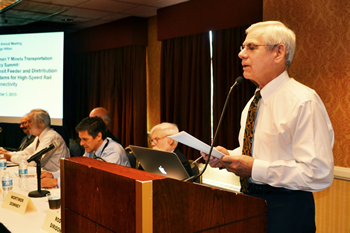
Rod Diridon opens the Connectivity Summit while panelists prepare for their presentations.
NEC breaks records, drives economic growth
Amtrak’s representative, Drew Galloway, was proud of the three record-breaking months in that region this year. “Philadelphia alone sends 4-5 trainloads to New York City each day, plus another 4-5 to Washington DC,” he said. “The Acela fits in with the Southeast Pennsylvania Transportation Authority (SEPTA) system, as well as with the bus networks and other transit. The average rider in the NEC travels 168 miles during each round trip. On the Acela, it’s 200 miles.”
The 30th Street Station in Philadelphia is the third-largest in the NEC, with one-third of its riders taking transit to reach the station. Current and planned remodeling will take that station into the next century, he said.
“Many people now want to live in city centers and not use their cars,” Mr. Galloway stated. “They prefer transit. A network of suburban transportation services also connects outlying people to the urban environment. We’re finding a good synergy between commuter rail and intercity rail, and riders are rapidly using smart devices to book travel and use them as ticketing.”
Texas plans a European-style system
In Texas, the visionaries are looking forward to implementing a plan that will connect the major economies of Houston and Dallas/Fort Worth, along with Austin and San Antonio. They expect additional economic development along the connecting corridors.
“We want to maximize transit-oriented development (TOD), among other approaches,” said Robert Eckels. “To accomplish our vision, we are collaborating with transit systems and the State of Texas. There is a place for all segments in a total transportation system, and we hope to capture value from TOD to help pay for our planned high-speed rail.”
To that end, Texas plans to have a European-style collector and distribution system. That means it will incorporate automobiles, buses, bicycles, railways, the highway system, and other modes to leverage the best possible economic generator for the state. Funding will come primarily from private investors, along with some investment from the state.
Connectivity links all transportation modes
Stan Feinsod wrapped up the presentations with a discussion of the latest MTI study about high-speed rail connectivity. “When we talk about connectivity,” he said, “we are talking more broadly than just connecting urban areas. We also are talking about linking the portal stations to the suburban areas.”
In the MTI study, Mr. Feinsod’s team reviewed 64 HSR stations around the world and developed 25 parameters for each. These included location descriptions, number of stations in the city, density, parking, connecting modes, and other factors. Transit modes were categorized as low capacity (taxi), medium capacity (bus), high capacity (tram, light rail), and very high capacity (regional or local commuter trains).
“It was apparent that HSR increases the overall transit ridership and use of local services,” he said. “The more transit-oriented the city, the better the connectivity. In fact, with new HSR stations, more transit services are introduced. And then those stations are used even by riders who do not take HSR because they become centers for other modes. This is especially true when the stations include shops, offices, and other destination uses.”
UDM summer program teaches high school students about transportation
Leo E. Hanifin, PhD, Professor, Department of Mechanical Engineering

A student works on his project at Transit Smart Moves, UDM’s summer transportation program.
UNIVERSITY OF DETROIT MERCY NEWS – The Transit Smart Moves Summer Program was conducted July 15-19, 2013 on the campus of University of Detroit Mercy, in the College of Engineering. Nineteen students representing more than 10 Detroit-area schools participated in the program. The 2013 summer program schedule included a Detroit Police Department drunk driving simulation, a tour of the Oakland County Road Commission, introduction to the LEGO NXT Mindstorms project, a discussion about equity in transportation, several sessions of LEGO Smart Moves, a discussion of roundabouts, a presentation on the architecture of urban planning and transportation, a UDM campus tour, and more. The week closed with student presentations of their Smart Moves projects, plus awards and recognitions for their fine work.
During the fall semester, a Saturday Transit Smart Moves program was conducted over the course of five weeks, during which the same program from the summer was utilized and expanded upon. Twenty-two metropolitan Detroit-area high school students participated in the program, along with an ACT Prep course to strengthen student skills in test taking as they prepare for college entrance. The students learned a great deal about the importance of transportation engineering and transit.
Seminar covers Las Vegas X-Train
Hualiang “Harry” Teng, PhD, Director, Railroad, High Speed Rail, and Transit Initiative
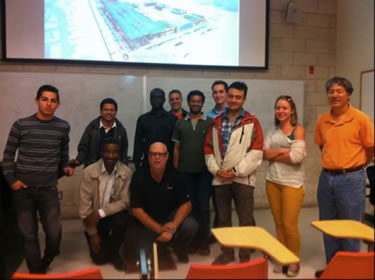
Seminar attendees included faculty, plus graduate and undergraduate students.
UNLV NEWS – On October 8, the University of Nevada, Las Vegas, hosted a railroad engineering seminar, Managing Large Scale Civil Engineering Projects in a Dynamic World, Case Study: North Las Vegas Station Four Phase Build-Out Approach, from Temporary Trackage & Platforms to Permanent Rail Facility. The speaker was Michael A. Barron, Chief Executive Officer, Las Vegas Railway Express, Inc.
Ten people attended the seminar, including four undergraduate and four graduate students and two faculty members.
They learned that developing a passenger railroad service is a dynamic process that has both engineering and non-engineering factors influencing the progress. They also learned that the X-Train project will build its station in North Las Vegas through several phases. It is expected that the social and economic impact of the passenger train service would be tremendous to not only North Las Vegas, but also the whole region of southern Nevada.
Biodiesel tests show possible use in transit buses
Ashok Kumar, PhD, Chair, Department of Civil Engineering

Experimental setup used to simulate biodiesel fuels combustion emissions.
UNIVERSITY OF TOLEDO NEWS – Biodiesel is an alternative renewable fuel with growing use in transportation. The University of Toledo (UT) has been involved in research on biodiesel emissions for the last eight years. Today, however, UT is working on the “Combustion Chemistry of Biodiesel for the Use in Urban Transport Buses.” This comes under a research grant from the US Department of Transportation, Research and Innovative Technology Administration through Mineta National Transit Research Consortium (MNTRC).
The project is being directed by Ashok Kumar, PhD, Department of Civil Engineering and Dong-Shik Kim, PhD, Department of Chemical & Environmental Engineering. Mr. Hamid Omidvarborna and Mr. Sudheer Kumar Kuppili are participating in the project for their PhD and MS work respectively.
Many studies reported in the literature show that biodiesel could reduce exhaust emissions of particulate matter (PM) from vehicles. In this study, the research team performed idling tests on two engines installed with a catalytic convertor to characterize PM. Different urban transit buses installed with Cummin engines running on B20 (20 vol% of soybean biodiesel with 80 vol% Ultra Low Sulfur Diesel or ULSD) were selected. Tailpipe The team collected PM on filter papers and measured Total Particulate Mass (TPM).
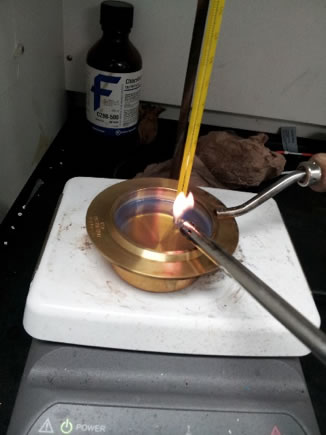
In the flash point test, the blue flame occurs at specific temperatures during the fuel heating process. The igniter is passed over the fuel to torch the fuel fumes.
An accredited elemental laboratory carried out elemental analyses, Elemental Carbon (EC), and Organic Carbon (OC) of PM. The results showed that PM emissions significantly decreased when using B20, and that newer transit buses have a greater PM reduction than old buses when using ULSD.
More than 12 elements were considered for the elemental analyses, and the results showed that Calcium (Ca), Iron (Fe), and Sodium (Na) were found in the high concentrations. OC/EC analyses showed that more OC was emitted in cold idling (greater than %80) than hot idling (greater than %65). Furthermore, OC/EC ratio was greater for new buses with convertors (from 9.57 to 13.37) than for old buses without converters (from 1.85 to 4.55).
Positive Matrix Factorization (PMF) showed that four sources (fuel, oil and lubricant, engine parts, and ambient air) contributed heavily to PM generation in the exhaust. In the second paper to model the effect of process conditions on emissions, experimental study on the combustion parameters of biodiesel and characterization of the exhaust are studied. High oxygenated content of biodiesel makes biodiesel combustion more complete at higher temperature and pressure. To determine which emission elements are originating from the biodiesel fuel after combustion, the team performed elemental analyses on the collected PM samples. The results detected nine elements in the samples under the set of temperatures (750º F and 850º F), pressures (300 psi and 400 psi), and different blends of different biodiesels studied.
The combustion chamber experiment was carried out, and emission gas was analyzed using Gas Chromatograph (GC). The research showed that as the biodiesel volume percent increased, the linearly increased combustion temperature and pressure linearly increased. Aluminum (Al), Calcium (Ca), Chromium (Cr), Iron (Fe), Potassium (K), Magnesium (Mg), Sodium (Na), Sulfur (S), and Silicon (Si) were the major elements found in the PM emissions, with Na being the highest component. Understanding key elements of this chemistry is an important step toward intelligently selecting engine design, feedstock, combustion conditions, and next-generation alternative fuels.
This paper focuses on the development of a simple model to reproduce the reaction pathways of the biodiesel combustion observed in the laboratory. The general findings are also compared with transit buses running on B20 biodiesel.
Physical properties (cloud point, kinematic viscosity, and flash point) of biodiesel blends were measured. The physical properties of the biodiesel can be accounted for the pollutants released during its combustion in an engine.
Four different biodiesel blends (10, 20, 50, 100%) based on three feedstocks (white grease, soybean, and waste cooking oil) were tested, and the results were compared with ultra-low-sulfur diesel (ULSD). Of course, all tests were conducted according to the American Society for Testing and Materials (ASTM) standard methods.
The tested properties showed strong dependence on blends, which means that the percentage of biodiesel in a biodiesel/ULSD mixture is an important factor that determines the biodiesel properties. The research also found that the type of feedstock is a controlling factor in the biodiesel properties. Contents of saturated fatty acids and triglycerides at higher percentages are thought to be the main determinant of the degree of the dependence. It also causes undesired variations in the cold flow properties, kinematic viscosity, and flash point.
These variations may be controlled through modifications in the trans-esterification process or by using additives, which is much needed for a better future in which biodiesel plays a vital role in transportation. The physical properties of the biodiesel can be accounted for the pollutants released during its combustion in an engine.
As a part of outreach activities, Mr. Omidvarborna and Mr. Kuppili will present individual posters at the Air and Waste Management Association’s (AWMA) 107th annual conference and exhibition in Long Beach, Calif., June 24-27, 2014.
Mr. Omidvarborna will present two papers – “Analysis of Particulate Matter (PM) from the Exhaust of Biodiesel Transit Buses under Idling Conditions” and “Experimental Evaluation of a Biodiesel Combustion Model Using a Laboratory Reactor” – in the technical and student poster sections.
Mr. Kuppili will present one paper, “Biodiesel Properties Depending on Blends and Feedstocks: Cloud Point, Kinematic Viscosity and Flash Point,” in the technical poster section.
-
Contact Us
San José State University One Washington Square, San Jose, CA 95192 Phone: 408-924-7560 Email: mineta-institute@sjsu.edu

